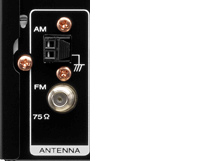The problem could be that the BLACK wire of the high level cable is not mated with the correct connection. This wire needs to be connected to a signal ground in your system. Typically this is the negative (-) output terminal of the amplifier, BUT NOT ALWAYS. When you are using a balanced differential or Class D designed amplifier, the negative output terminal is never signal ground.
Signal ground can be found in a few places on most integrated amps, pre-amps, or processors.
- RCA rings are frequently a source of signal ground. Remember that RCA connections are coaxial. The signal runs through the center wire and pin, and ground runs through the shield which is the outer ring.
- Phono ground lugs are an excellent connection to ground.
- Antenna Earth ground connections are also a good connection
Solutions:
- Instead of connecting the BLACK wire of the high level cable, simply make a connection between an unused RCA on your system and the LFE input on the REL. The outer rings of the RCA will connect the REL to signal ground of the system. Set the LFE level on the REL to minimum to avoid interference and tape off the BLACK wire of the high level cable to insulate against accidental shorting.

If you are connecting to a theatre system, you are already making this connection between the SUB OUT of your processor to the LFE input of the REL. In this case just leave the BLACK wire disconnected and tape off to avoid accidental shorting.
- Solder the BLACK wire of the REL high level cable to the ring connection of an RCA plug and connect it to an unused RCA input on your system.
- Connect the BLACK wire to the ground lug provided for phono input on integrated amp or pre-amp.
- Connect the BLACK wire to the Earth connection for radio antenna on amplifier.
Radio antenna inputs are often compression or coaxial.
 |
For compression connections, simply push the release in and stick the black wire into the ground input. For coaxial connections, the black wire can be wrapped around the threads and twisted together. |

Comments
6 comments
I have a T5i that hums, tried the fixes in the video and it still hums. Also tried power through Audiolab DC block. No joy. Have you any more suggestions? Obviously can’t hear it when music playing but it does annoy, and arguably shouldn’t be there.
Hello, I have a REL T9x and I've already tried all the suggested alternatives, but it still hums. My equipment consists of a McIntosh C22 preamp and a McIntosh MC240 amplifier. I'm not sure if it's because they're vintage, but I haven't been able to eliminate the hum. I really hope you can help me. Thank you.
I sense your frustration and feel your pain. I think we have to put our pursuit of perfection (within budget) and just live with it. I’ve managed to move on. I still love the warmth and depth and of course bass the woofer gives
Okay, I had humming for about 5 minutes on my pair of REL T-7x's until I realized what I was doing wrong- You may be overloading a circuit with too much power demand. Too much power demand will cause humming, as the transformers deal with power sag poorly by humming.
Also, it could be overloading the power conditioner or strip you have in use with your system with too many components and each of their power demands. With 2 subs and a large system on one Monster Cable '3500, the subs hummed. Moving each of the subs to another power outlet and using longer power cables for the connection solved the issue immediately.
Watch the video above. None of your MacIntosh gear should cause the subs to hum because they're vintage equipment. It should be that those components draw a lot off of the electricity from the wall / circuit and the subs do too.
While I love my REL subs, I can see where people may not have the space nor the extra outlets to accommodate 2 subs in stereo (as preferred by many as bass IS directional).
Thank you very much for the advice. I have all my equipment connected to a Furman, including the REL 9Tx subwoofer. I'm going to try separating it from that area and plugging it into another outlet to see if that eliminates the hum. It's very faint, but I can still hear it at very low volume.
Remember, hum at any volume is an indication how the power supply is reacting to the load. If it's a little bit, it might be tolerable, but I wouldn't live with it as it may mean lower life span for the power supply and therefore the sub.
Please sign in to leave a comment.